

Ammit. Ammit (/ˈæmɨt/; "devourer" or "soul-eater"; also spelled Ammut or Ahemait) was a female demon in ancient Egyptian religion with a body that was part lion, hippopotamus and crocodile—the three largest "man-eating" animals known to ancient Egyptians.
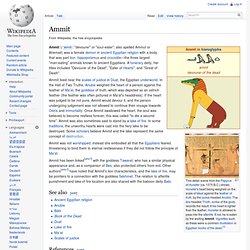
Basilisk. Accounts[edit] The basilisk is called "king" because it is reputed to have on its head a mitre- or crown-shaped crest.

Black Tortoise. History[edit] In ancient China, the tortoise and the serpent were thought to be spiritual creatures symbolizing longevity.

The Fujianese custom of building turtle-shaped tombs may have had to do with the desire to place the grave under the influence of the Black Tortoise.[1][2] During the Han dynasty, people often wore jade pendants that were in the shape of turtles. Because of ancient Chinese influence on Japan, honorific titles and badges in Japan also often referred to the turtle or tortoise. Chinese dragon. "Loong" redirects here.
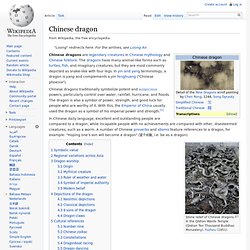
For the airlines, see Loong Air. Chinese dragons traditionally symbolize potent and auspicious powers, particularly control over water, rainfall, hurricane, and floods. Cipactli. Cipactli (Classical Nahuatl: Cipactli) 'Crocodile' or 'Caiman', was the first day of the Aztec divinatory count of 13 X 20 days (the tonalpohualli), and Cipactonal 'Sign of Cipactli' was considered to have been the first diviner.[1] In Aztec cosmology, the crocodile symbolized the earth floating in the primeval waters.

According to one Aztec tradition, Teocipactli 'Divine Crocodile' was the name of a survivor of the flood who rescued himself in a canoe and again peopled the earth.[2] In the Mixtec Vienna Codex (Codex Vindobonensis Mexicanus I), Crocodile is a day associated with dynastic beginnings.[3] In Aztec mythology, Cipactli was a primeval sea monster, part crocodile, part fish and part toad, of indefinite gender.
Always hungry, every joint on its body was adorned with an extra mouth. The deity Tezcatlipoca sacrificed a foot when he used it as bait to draw the monster nearer. He and Quetzalcoatl created the earth from its body. Notes[edit] References[edit] Dragon. A dragon is a legendary creature, typically with serpentine or reptilian traits, that features in the myths of many cultures.
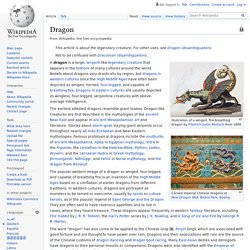
There are two distinct cultural traditions of dragons: the European dragon, derived from European folk traditions and ultimately related to Greek and Middle Eastern mythologies, and the Chinese dragon, with counterparts in Japan (namely the Japanese dragon), Korea and other East Asian countries.[1] Emela-ntouka. The Emela-ntouka is an African legendary creature in the mythology of the Pygmy tribes, and a cryptid purported to live in Central Africa.

Its name means "killer of the elephants" in the Lingala language. In other languages it is known as the Aseka-moke, Njago-gunda, Ngamba-namae, Chipekwe or Irizima.[1][2] Description[edit] The Emela-ntouka is claimed to be around the size of an African Bush Elephant, brownish to gray in color, with a heavy tail, and with a body of similar shape and appearance to a rhinoceros, including one long horn on its snout. Keeping its massive bulky body above ground level supposedly requires four short, stump-like legs. Kongamato. History[edit] Frank Melland, in his 1923 book In Witchbound Africa, describes it as living along certain rivers, and very dangerous, often attacking small boats, and anybody who disturbed the creature.
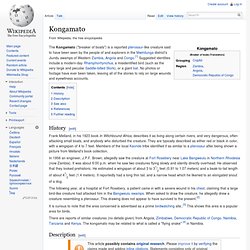
They are typically described as either red or black in color, with a wingspan of 4 to 7 feet. Members of the local Kaonde tribe identified it as similar to a pterosaur after being shown a picture from Melland's book collection. In 1956 an engineer, J.P.F. Brown, allegedly saw the creature at Fort Rosebery near Lake Bangweulu in Northern Rhodesia (now Zambia). Kurma. In Hinduism, Kurma (Sanskrit: कुर्म) was the second Avatar of Vishnu, succeeding Matsya and preceding Varaha.

Like Matsya this incarnation also occurred in Satya yuga. Loch Ness Monster. The Loch Ness Monster is a cryptid, a creature whose existence has been suggested but is not discovered or documented by the scientific community.[3] It is reputedly a large unknown animal that inhabits Loch Ness in the Scottish Highlands.
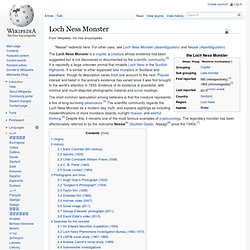
It is similar to other supposed lake monsters in Scotland and elsewhere, though its description varies from one account to the next. Popular interest and belief in the animal's existence has varied since it was first brought to the world's attention in 1933. Evidence of its existence is anecdotal, with minimal and much-disputed photographic material and sonar readings. Origins Loch Ness History Saint Columba (6th century) Mbielu-Mbielu-Mbielu. The Mbielu-Mbielu-Mbielu is a cryptid reported from the Likouala Region of the Republic of the Congo. Only a few claimed sightings have been reported, at the villages of Bounila and Ebolo, which were collected by the cryptozoologist Roy Mackal.[1] No physical evidence for the creature exists.
Apparently herbivorous, it is described as "the animal with planks growing out of its back" - which has led some writers on the subject to suggest one of the Stegosauridae, most likely a Kentrosaurus. The animal appears to be aquatic,[2] and has mostly green algal growth covering the "planks". See also[edit] References[edit] Jump up ^ Mackal, Roy P. Other sources[edit]
Mokele-mbembe. Mokèlé-mbèmbé, meaning "one who stops the flow of rivers" in the Lingala language is a legendary water-dwelling creature of Congo River basin folklore, sometimes described as living creature, sometimes as a spirit, and loosely analogous to the Loch Ness Monster in Western culture. It is claimed to be a sauropod by some cryptozoologists.[1] Expeditions mounted in the hope of finding evidence of the Mokèlé-mbèmbé have failed, and the subject has been covered in a number of books and by a number of television documentaries.
According to skeptic Robert T. Carroll, "Reports of the Mokèlé-mbèmbé have been circulating for the past two hundred years, yet no one has photographed the creature or produced any physical evidence of its existence. Ngoubou. The Ngoubou is a purportedly surviving ceratopsian-like cryptid in the savanna region of Cameroon.[1] It is said to have six horns, and fights elephants for land, despite its smaller size (about the size of an ox, according to locals).[2] In November 2000, William Gibbons did some preliminary research in Cameroon for a future Mokele-mbembe expedition. He was accompanied by David Wetzel. While visiting with a group of pygmies they were informed about an animal called Ngoubou. Although ngoubou is also the local word for rhinoceros, the pygmies asserted this was not a regular rhinoceros, as it had more than one horn (six horns on the frill in one account), and further stated that the father of one of the senior members of the community had killed one with a spear a number of years ago.
The locals had noted a firm decline in the population of these animals lately, making them harder to find. Possible sighting[edit] See also[edit] Sewer alligator. A model of an alligator emerging from a sewer in a mall. Sewer alligator stories date back to the late 1920s and early 1930s; in most instances they are part of contemporary legend. They are based upon reports of alligator sightings in rather unorthodox locations, in particular New York City.
Sobek. Sobek (also called Sebek, Sochet, Sobk, and Sobki), and in Greek, Suchos (Σοῦχος) was an ancient Egyptian deity with a complex and fluid nature.[1] He is associated with the Nile crocodile and is either represented in its form or as a human with a crocodile head. Sobek was also associated with pharaonic power, fertility, and military prowess, but served additionally as a protective deity with apotropaic qualities, invoked particularly for protection against the dangers presented by the Nile river. History[edit] Sobek enjoyed a longstanding presence in the ancient Egyptian pantheon, from the Old Kingdom (c. 2686—2181 BCE) through the Roman period (c. 30 BCE—350 CE). Taniwha. Wyvern. Zaratan. The Zaratan is a grandiose sea turtle found in literature and folk lore. Zaratans are notable for their long-life span and impossible size.
Zaratan shells are easily mistaken for small islands, similar to the whale-like Fastitocalon. The Zaratan is catalogued in Jorge Luis Borges's El Libro de Los Seres Imaginarios (The Book of Imaginary Beings). Aspidochelone.